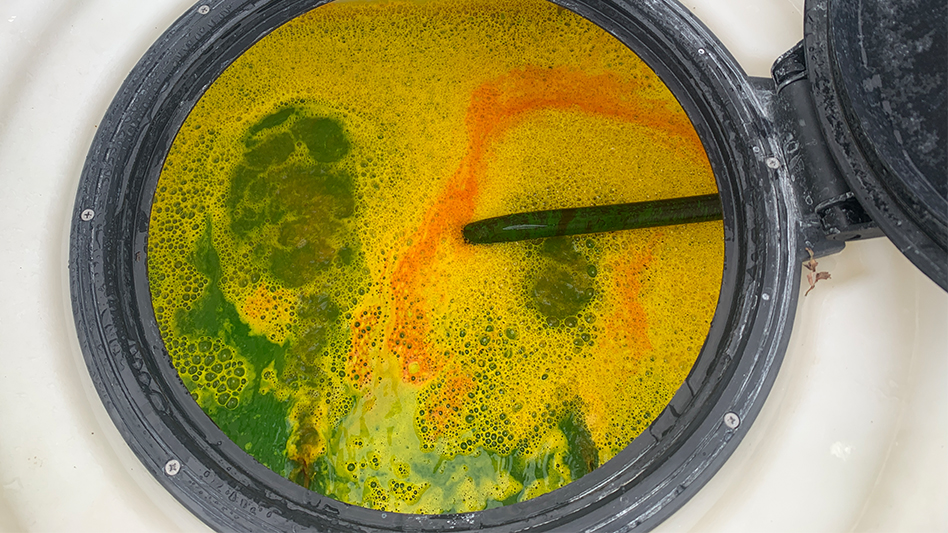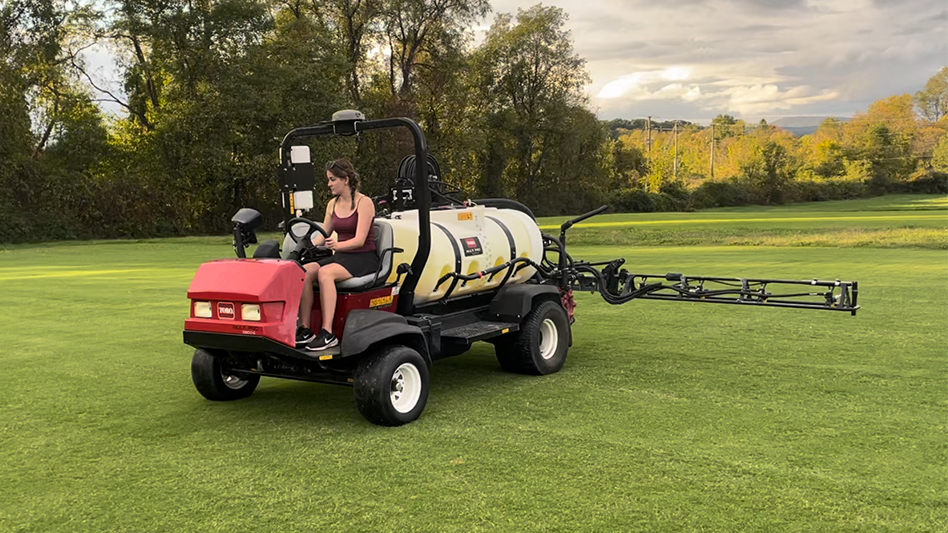
Courtesy of Elisabeth Kitchin
Elisabeth Kitchin was raised on a small, family-owned farm in North Carolina. The main crops were asparagus and maple syrup and to thrive, practical problem-solving was essential. With that upbringing, Kitchin is a natural fit in the turf industry and she is already a dedicated advocate for practical solutions.
As a graduate student at Virginia Tech, Kitchin has been working to further understand sprayer precision. “Targeted applications are useful but not a lot is known about the quantifiable accuracy and the precision of the sprayers when we are making them,” Kitchin says. “We need to determine how different factors, such as speeds of travel and target sizes, influence results.”
Each trial started with Kitchin mapping and spraying targets on the fairways of Virginia Tech Golf Course in Blacksburg, Virginia, during daylight. The turf was sprayed with a solution of UV dye mixed with water to act as a proxy for pesticides. “It’s a xanthene dye that is typically used in sewage systems for water-tracing and plumbing purposes,” she says. “It is completely biodegradable, relatively cheap and it’s safe on the turfgrass. It’s only about $80 per gallon and easy to source.”

At night, she and four other members of the VT Turfgrass team would push UV lights across the fairway. “I painted our targets with a neon paint so when we illuminate the fairway we are able to see the paint and the exact spray deposition,” Kitchin says. “Not only are we able to see where we sprayed but also the pattern of the intensity of the dye, any skew and a very defined shape.”
With the targets and deposition illuminated, they would use a drone to take images. All that can be seen is the orange target and the green illuminated UV dye that was deposited. “The sprayer we are using has individual nozzle controls and our targets are circular or like an oval,” Kitchin says. “We can see what nozzles are turning on, the different shapes and patterns and things like that.” That’s visibly promising.
“The results are great. The GPS sprayers have incredible accuracy,” Kitchin says. “The majority of the time they are hitting 100 percent coverage of the intended targets. There’s a bit of overspray, like the sprayer turning on before it hits the target or staying on a little bit after.” That’s good from a practical perspective. It’s better to overspray than miss affected areas and have disease break through.
Kitchin reported that target size has no significant effect on the accuracy or the precision, from half a meter to two meters in diameter. Speed was tested at intervals of 3, 4½ and 6 miles per hour.

“Speed does have an effect. Going slower, around 3 miles per hour, has a significantly lower accuracy and a higher offset — more of a difference between where the machine is spraying and where we are telling it to spray,” Kitchin says. That’s good news for superintendents, too — get the job done with some speed for better accuracy.
Supporting the research was superintendent Jason Ratcliff, who started as a mechanic and has worked his way through several positions at Virginia Tech Golf Course during the past 29 years. “I've been fortunate to work with talented individuals on many research projects,” Ratcliff says.
“Jason has been awesome and super accommodating,” Kitchin adds. “The neon orange targets are obnoxious but the whole crew has been super nice. They let us come and spray the dye even though we had never used it with turfgrass before.” The dye was water soluble, disappearing with the dew or a single rain event, but even so, Kitchin would wait about a week between trials.
Ratcliff promotes research for the good of the course, to acquire funding for future projects and to help students further their careers. “You can't put a price tag on that,” he says. “My biggest fear is that I do something that will negatively impact the research being conducted. Communication with the students is key and I do this on a daily basis.”
Kitchin will be sharing full results this spring, when she is completing her master’s degree. Dr. David McCall has been her advisor and will continue to work with Kitchin as she pursues her doctorate.
Kitchin served as a USGA Green Section intern and has positive experiences working with superintendents. She appreciates their openness to making data-driven decisions and recognizes that costs, time and labor availability can be barriers to adopting new technology.
“Technology has so much potential,” she says. “A lot of effort goes into working with GPS sprayers, especially with making targeted applications. People are adopting what is possible. It is up to us as researchers to make it more adoptable. It’s not reasonable for us to say they should be using this technology if it’s not feasible, it’s very expensive or incredibly time-consuming. There is no use in having amazing technology if it’s not going to be practical.”
She really appreciates the work and the people she works with. “It’s like a little sweet spot between my interests in sustainability and my love of working in turf pathology and in the turfgrass industry,” Kitchin says. “We are lucky that everyone is open and supportive of each other. I hope I can continue to do this research and communicate these results to provide practical, adoptable solutions for turfgrass managers.”
Lee Carr is a northeast Ohio-based writer and senior Golf Course Industry contributor.
Get curated news on YOUR industry.
Enter your email to receive our newsletters.Latest from Golf Course Industry
- Golf Construction Conversations: Stephen Hope
- EnP welcomes new sales manager
- DLF opening centers in Oregon, Ontario
- Buffalo Turbine unveils battery-powered debris blower
- Beyond the Page 66: Keep looking up
- SePRO hires new technical specialist
- Plant Fitness adds Florida partner
- LOKSAND opens North American office







